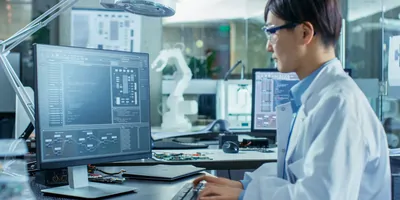Big Picture
Automation Implementation Strategies: A Roadmap for Your Lab
UpdatedAutomation has become a key tool for many labs, with growing potential to save time and improve accuracy. But lab managers must make a variety of decisions before implementing automated solutions, such as identifying the appropriate level of automation needed, determining if the lab's current design can accommodate automation, and how to get staff on board to use it. This six-part series covers all the key considerations of implementing and optimizing laboratory automation.
The Next-Generation Laboratory
UpdatedWith the advent of artificial intelligence, the remote revolution, and other such shifts, it's clear that the workforce is changing—and laboratories are no exception. If companies wish to succeed in the long run, they must take strategic steps now to change in step with the workforce at large. Labs that embrace these changes and strive to stay ahead of the curve will be primed for a level of efficiency, flexibility, and capability not previously experienced.
This five-part series explores how R&D companies can position their labs to stay competitive by adopting cutting-edge technology, designing labs to encourage collaboration, and retaining the talent needed to lead the lab to success in the next generation.
Ensuring Quality Control in Pharmaceutical Processes
UpdatedQuality control (QC) can be a significant challenge for pharmaceutical laboratories. Without a robust system for ensuring product quality, labs will have a higher margin for error, be prone to falling out of compliance with regulations, and are subject to losing time in regulatory inspections.
This series will share insight that QC lab leaders can implement as part of their QC processes, including how to minimize human errors, effectively responding to questions from regulators, and how a new HPLC system can mitigate common errors in liquid chromatography.
How to Improve Your Decision-Making Skills
UpdatedLab managers are tasked with making a variety of important decisions to benefit their team and organization. Such decisions include: determining when to promote staff, how to handle layoffs or poor performers, where to make investments to improve lab operations, when to hire external help and consultants, among countless others. Making these types of decisions requires evaluating the right data, consulting with other stakeholders, and thoughtfully analyzing the possible outcomes of your decision. This five-part series explains how to use key performance indicators (KPIs) and other metrics to evaluate the status of your lab. It then offers a few examples of some of the complex decisions lab managers commonly have to make, and steps toward effectively resolving these decisions.
Run Your Lab Like a Business
UpdatedManaging a laboratory requires complex decision-making, and extensive business and operations knowledge. Lab managers need to develop a unique skill set and work with departments outside the lab to lead the organization to success. This seven-part series outlines strategies to effectively manage the different aspects of running a lab, such as inventory and asset management, advocating for investments, proper budgeting, and employee engagement.
Innovations in Cell Imaging
UpdatedCell imaging plays a crucial role in enabling scientists to better understand cell behavior and function, and now a variety of technological advances and new capabilities are playing a key role in enhancing life science research. This four-part series will highlight some of the latest developments in cell imaging technology and how they are being applied to different applications, such as COVID research, neuroscience, and other biology research.
Fume Hood Safety and Sustainability
UpdatedFume hoods are essential to lab safety, but they are also some of the most significant drivers of energy consumption in the lab. While there are ways to make a lab more environmentally friendly without necessarily sacrificing safety, such as the use of ductless fume hoods, these opportunities are often passed over due to false assumptions about what the lab needs based on legacy processes and tradition. Consequently, many labs lose money and are held back from reaching sustainability targets as they only consider the use of ducted fume hoods over ductless.
This eight-part series explores the benefits of ductless fume hoods in terms of safety and sustainability, along with what buyers should know about ductless fume hoods and how challenging the status quo can drive innovation.
How to Become a Lab Manager
UpdatedLab managers often enter into the role without any formal leadership or management training, causing them to learn on the go, by trial and error. But becoming an effective, trusted lab manager is a complex challenge that requires the development of a diverse set of skills and knowledge. This series explains the different stages of lab management, provides aspiring leaders with resources and tips to help them better prepare for a higher-level role, and shares key traits and qualities of effective managers.
The Importance of Training and Development in the Lab
UpdatedThe ongoing training and development of laboratory staff is necessary for the long-term success of an organization. A variety of trainings are required, such as management, leadership, technical skills, and safety, among others. Training and development can be done through different methods, from online courses to in-person workshops, and many options are little to no cost. This six-part series outlines why lab managers should thoughtfully prepare a training and development strategy for their teams, the benefits of doing so, and provides specific examples of internal training options.
Harnessing Informatics to Optimize Lab Operations
UpdatedAre you getting the most out of your lab's software?
Informatics play a key role in the modern laboratory. But not all labs are exercising their software's full potential, wasting time and money while leaving more room for error.
This six-part series offers insight on the different types of lab software, selecting the right platform, onboarding new users, and more. By the end of the series, you will be equipped to improve your lab's informatics solutions and optimize processes across a variety of domains, from risk management to chromatography.










